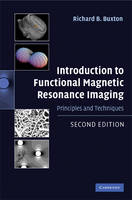
Introduction to Functional Magnetic Resonance Imaging
Cambridge University Press (Verlag)
978-0-521-89995-6 (ISBN)
Functional Magnetic Resonance Imaging (fMRI) has become a standard tool for mapping the working brain's activation patterns, both in health and in disease. It is an interdisciplinary field and crosses the borders of neuroscience, psychology, psychiatry, radiology, mathematics, physics and engineering. Developments in techniques, procedures and our understanding of this field are expanding rapidly. In this second edition of Introduction to Functional Magnetic Resonance Imaging, Richard Buxton – a leading authority on fMRI – provides an invaluable guide to how fMRI works, from introducing the basic ideas and principles to the underlying physics and physiology. He covers the relationship between fMRI and other imaging techniques and includes a guide to the statistical analysis of fMRI data. This book will be useful both to the experienced radiographer, and the clinician or researcher with no previous knowledge of the technology.
Richard B. Buxton is Professor of Radiology and Director of Magnetic Resonance Research at the University of California at San Diego.
Part I. An Overview of Functional Magnetic Resonance Imaging; Section 1. Introduction to the Physiological Basis of Functional Neuroimaging: 1. Neural activity and energy metabolism; 2. Cerebral blood flow and brain activation; Section 2. Introduction to Functional Magnetic Resonance Imaging: 3. Nuclear magnetic resonance; 4. Magnetic resonance imaging; 5. Imaging functional activity; Part II. Principles of Magnetic Resonance Imaging; Section 1. The Nature of the Magnetic Resonance Signal: 6. Basic physics of magnetism and NMR; 7. Relaxation and contrast in MRI; 8. Diffusion and the MR signal; Section 2. Magnetic Resonance Imaging: 9. Mapping the MR signal; 10. MRI techniques; 11. Noise and artifacts in MR images; Part III. Principles of Functional Magnetic Resonance Imaging; Section 1. Perfusion Imaging: 12. Contrast agent techniques; 13. Arterial spin labeling techniques; Section 2. Blood Oxygenation Level Dependent Imaging: 14. The blood oxygenation level dependent effect; 15. Design and analysis of BOLD experiments; 16. Interpreting the BOLD response; Appendix. The physics of NMR.
| Erscheint lt. Verlag | 27.8.2009 |
|---|---|
| Zusatzinfo | 8 Plates, color; 54 Halftones, unspecified |
| Verlagsort | Cambridge |
| Sprache | englisch |
| Maße | 164 x 240 mm |
| Gewicht | 920 g |
| Themenwelt | Medizin / Pharmazie ► Medizinische Fachgebiete ► Neurologie |
| Medizinische Fachgebiete ► Radiologie / Bildgebende Verfahren ► Kernspintomographie (MRT) | |
| Naturwissenschaften ► Biologie ► Humanbiologie | |
| Naturwissenschaften ► Biologie ► Zoologie | |
| ISBN-10 | 0-521-89995-8 / 0521899958 |
| ISBN-13 | 978-0-521-89995-6 / 9780521899956 |
| Zustand | Neuware |
| Informationen gemäß Produktsicherheitsverordnung (GPSR) | |
| Haben Sie eine Frage zum Produkt? |
aus dem Bereich


